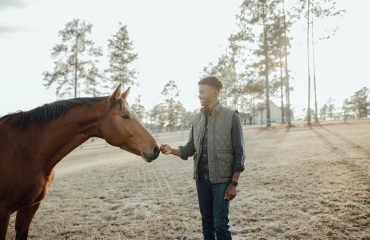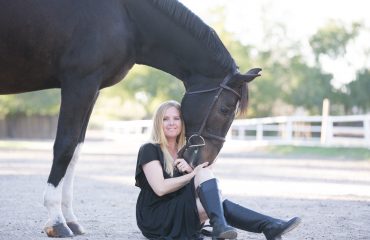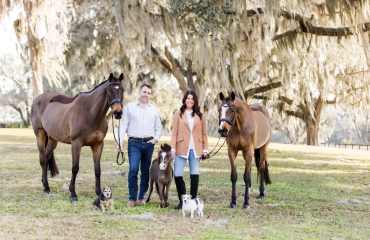Axel Steiner is a genuinely gracious, unofficial global ambassador of dressage. His riding began at the age of nine in Germany where he later attended two schools: Warendorf, which conducts tests of trainers, and Neindorff, founded by Egon von Neindorff, author of “The Art of Classical Horsemanship.”
After Axel’s move in to the US 1961, he competed his own as well as horses owned by the US Modern Pentathlon Team (fencing, shooting, swimming, cross-country running and riding) until his duties in the US Air Force called a halt to his competitive drive.
Axel has judged in 35 countries from shows in remote equestrian outposts to the World Cup Finals, Pan Am and Olympic Games. Granted his first National judge’s license in 1968, his status was elevated to FEI-O, now designated FEI-***** (five star), in 1988, the year he retired as a Lt. Colonel. Popular as a teacher and clinician, Axel is a long-time member of the USEF Dressage Committee, a judge-examiner, and serves on the faculty of the USDF “L” program. He lives in California with his wife, the well known equestrian artist and photographer, Terri Miller Steiner.
Sidelines: How has dressage changed for the better?
AS: The quality of the horses has improved greatly, certainly in the last 10 years. It’s getting better each year that new horses and new young three and four year olds are coming out: they’re getting better and better for the simple reason that they are now being bred for the sport. They’re not the all purpose type horse that could probably do most anything. They’re now carefully bred for the dressage, and it really shows. The riding and training over the years has gotten much better, recognizing some of the bio-mechanical principles. So everything has become much more sophisticated.
Sidelines: Is horse quality the main reason we’re scoring better internationally?
AS: No, I don’t think that’s it. The world’s horses are getting better. It isn’t just our horses. Horses in general around the world are getting better, especially in Europe. Most of the horses we get come from Europe. The reason why we are getting closer to the European standard is because we spend quite a bit of time competing and training in Europe, picking up the European training ideas.
Sidelines: What are the challenges of judging the best?
AS: Judging is always a challenge because you put your career and your reputation on the line every time a horse comes down the centerline. So you’re trying to do the best job you can.
Sidelines: Do you fancy riding a superstar horse and who would it be?
AS: Everybody would love to sit and feel what piaffe and passage on Totilas would feel like – absolutely! I would love to get the feel now with one of these three and four year old horses of how much different they are than the older traditional horses that I grew up with – absolutely! Would I do it? No. But I still work with a lot of riders and horses from the ground.
Sidelines: What good has come out of the Hyperflexion debate?
AS: Anything that is forced is no good. At the same time I see the pendulum swing the other way, and we have some people so hypersensitive that anytime a horse comes a little bit behind the vertical they’re screaming “Hyperflexion!” which is total nonsense. For a horse to be properly gymnastically worked they have to be worked a little low and behind the vertical to really be able to loosen the back. It just has to be done properly and humanely with lots of breaks in between.
Sidelines: What do you think of the partnership between Moorlands Totilas and Edward Gal?
AS: That’s really what it was: it truly was a partnership. They’d known each other quite a while and because anytime you know each other quite a while, you may be able to communicate your wishes without everybody seeing it and do it relatively quietly. The horse understood he had the confidence that the rider would let him do it and not interfere. It looked sometimes like Edward was sitting there passively and letting the horse do his dancing: it was just a nice relationship, the same that a good couple should have on the dance floor.
Sidelines: Will Mathias Rath develop a similar partnership with Totilas?
AS: Mathias is a very nice rider, and I think he’s a bit overwhelmed. All the pressure they put him under probably took its toll a little bit. I’m sure it will be a different partnership with the different training methods, but eventually he will do a fine job with Totllas. Will it be as Edward had? Maybe not. Maybe less brilliant in some ways, maybe in some areas technically more correct. I wish them well. I feel a little sorry for Mathias, in that kind of a pressure cooker. I’m sure he would like to ride and get to know the horse without everybody watching.
Sidelines: What about our Pan Am team?
AS: Steffen Peters is right now the leader on both teams: the leader on the small tour team for Pan Am [with Weltino’s Magic] and certainly right now the leader with Ravel, the potential engine [for the Olympics], but we need a few more cabooses. Heather Blitz is a good rider on a very imposing horse [Paragon] and he’s very impressive in St. Georges. He’s relatively young and I’m sure he will be great for the Pan Ams. For Grand Prix we have to wait a little bit. Cesar Parra has had consistently good horses and tries to be very competitive. Whatever horse he has at the time will make or break it for him. Right now he has a nice horse [Grandioso] and he’s on the small tour team. Marisa Festerling [Big Tyme] has been around for quite a while. She really shone at Gladstone: very solid rider, very nice horse, very consistent over the three days. That’s what you’re looking for when you send a team to a major competition, consistent horses.
Sidelines: How do you feel about the helmet rule changes?
AS: People are working on a safety top hat. My question, right now, is do we really need it? It’s so difficult to have a safety top hat with the edges that are necessary for a top hat. Some of the new safety helmets coming out are really attractive and a number of the riders look really good in them. You just have to get used to the look. I’d go a step further: I would like to change our riding uniform a little bit. It doesn’t make any sense to ride in 100 degree weather in a shadbelly. We should have a summer uniform. Some of the little jackets that people wear at auctions are very attractive, cover what they need to cover and look smart. We have to get away from the old fashioned somewhat stilted ways we have of presenting ourselves.
Sidelines: What is it about dressage that still captivates you?
AS: I started riding dressage as a child: we had to ride a little jumping, a little cross country, vaulting, dressage. We had to become all around horse children, horse young people (laughs): it’s kind of stuck. Dressage is never the same: every day is different. I like the challenge, I enjoy working with the people – they’re normally very dedicated. If you do it right, you can see the progression in the horse. To do it right is the key.
Sidelines: Do you still ride?
AS: If I have the chance to get on something that’s nice and friendly and it’s a trail ride, I never say no. A couple years ago I rode a Paso Fino in paso gait across a field with a champagne glass in my hand: that was wonderful. We don’t have our own horses anymore: with my wife’s travel schedule and mine, we ride airplanes more often than we ride horses!
Sidelines: If you’re teaching a clinic, what three ‘lessons’ do you want riders to take with them?
AS: Listen to your horse. Try to make him the best he can be. Have fun doing it.
-Lauren Giannini














